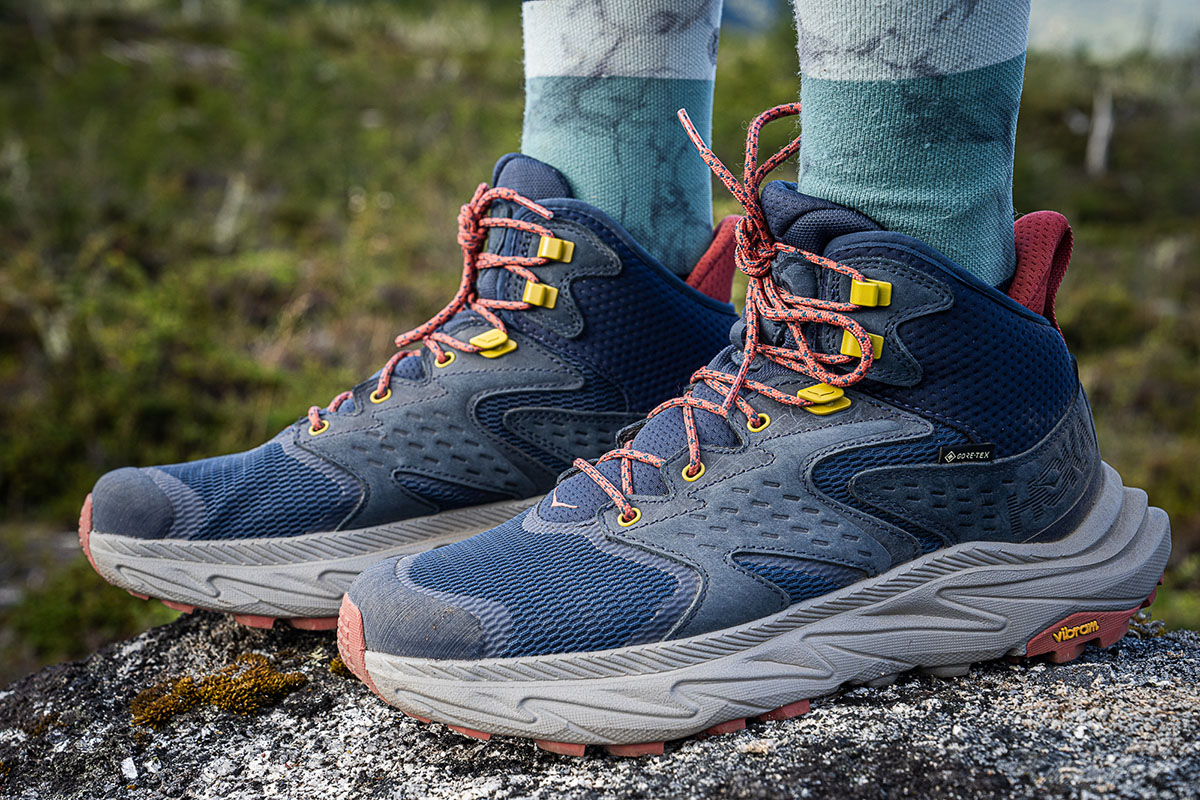
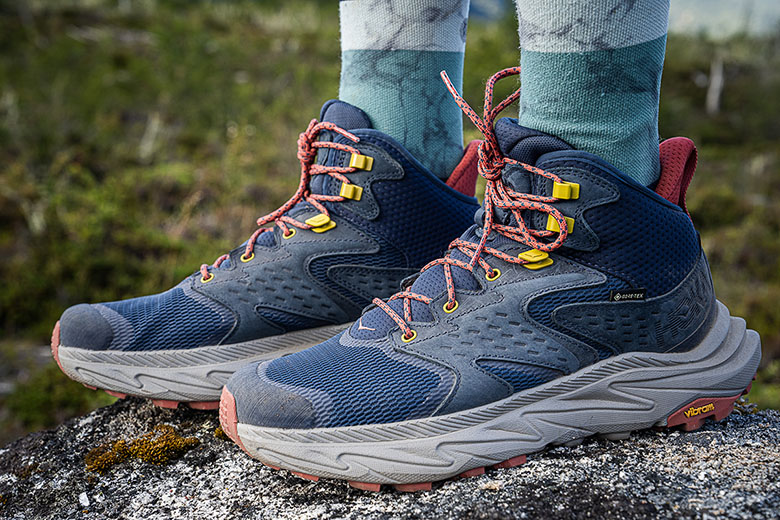
Price: $195
Weight: 2 lb. 4 oz. (men’s)
Waterproof: Yes (Gore-Tex)
What we like: Extremely comfortable, great fit, and smooth ride—a Hoka boot through and through.
What we don’t: We have durability concerns about the blown rubber in the middle of the outsole; laces below the top two eyelets are stiff and difficult to snug down.
See the Men's Anacapa 2 Mid GTX See the Women's Anacapa 2 Mid GTX
Running brand Hoka has been aggressively growing their hiking footwear collection of late, and the Anacapa Mid is arguably their best effort yet. Now in its second iteration, this boot combines the smooth ride and excellent cushioning that the company is known for with over-the-ankle height and protection, a great fit that’s snug in the heel and decently roomy in the toe box, and a reasonably light weight. We do have some durability concerns with the blown rubber in the middle of the sole, and the stiff laces made it difficult to achieve a snug fit over the top of the foot. But overall, the Anacapa Mid is a quality option for on-trail hikers who put a premium on comfort. Below we break down our experiences with the Anacapa 2 Mid. To see how it stacks up to the competition, check out our article on the best hiking boots.
Cushioning and comfort are hallmarks of Hoka’s running and hiking footwear (including the original Anacapa), and the Anacapa 2 Mid GTX is no exception. For starters, the boot has a classic Hoka feel thanks to the generous squish underfoot and the outsole’s rockered shape. In practice, it’s easy to move quickly over the trail—and even jog for stretches—and the Anacapa feels exceptionally smooth when you’re in a rhythm. In my opinion, this is easily the biggest appeal of the Hoka boots: You’re getting over-the-ankle protection and moderate support, but foot fatigue is kept to an absolute minimum, even when wearing them all day long over rocky trails.
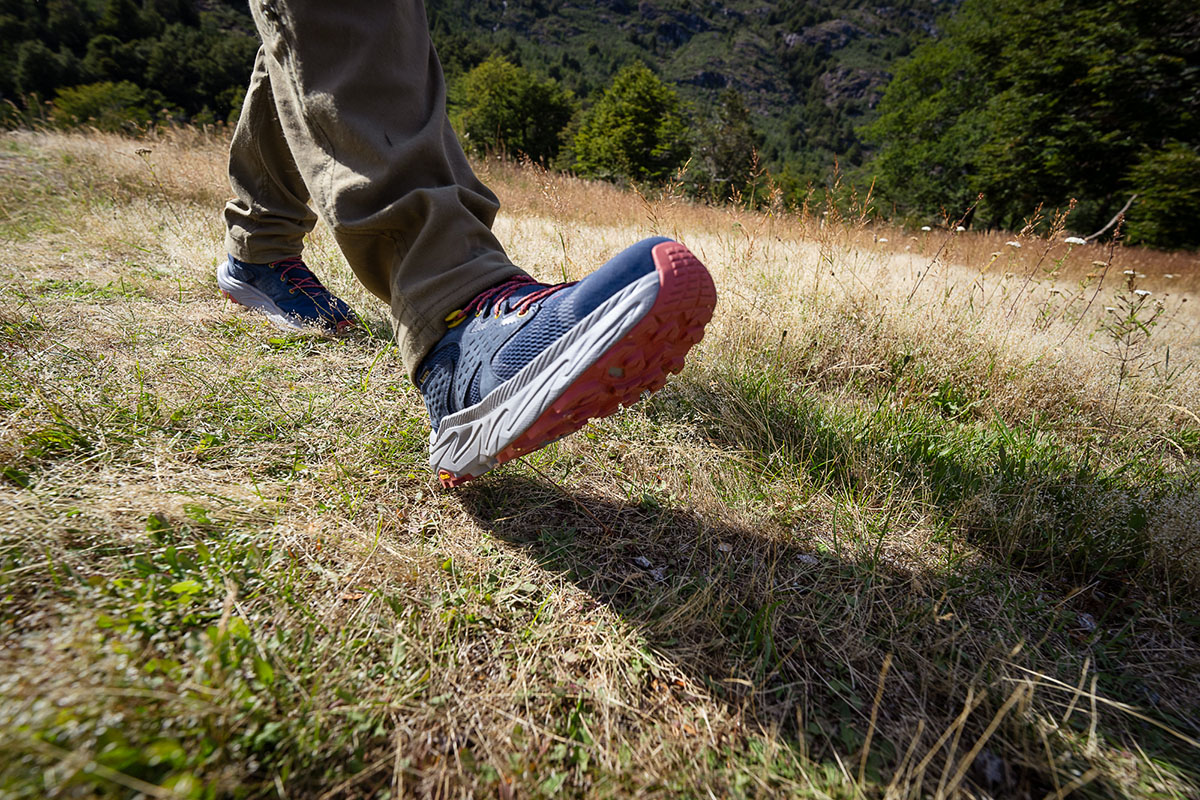
Another contributor to the Anacapa’s excellent comfort is its lacing system, which incorporates three sets of locking eyelets at the top to provide a very secure fit. With a just-right, snug heel cup, I didn’t experience any rubbing or blister concerns on multiple technical day hikes in Chilean Patagonia. The laces below the top two eyelets are a little stiff and difficult to snug down over the top of the foot (more in “Fit and Sizing” below), but achieving the right fit isn't impossible with some patience. Additionally, there’s plenty of room for the toes to spread out and swell up during the day. Rounding out the design, you get generous padding around the ankles, and gussets on the tongue keep it nicely in place to avoid pressure points when cinching up the laces (an issue I often run into when breaking in new hiking boots). Putting on the Anacapa can be a little tedious due to the fact that the design dips low behind the heel, but it’s far from a dealbreaker and easy to accomplish with the laces completely loosened.
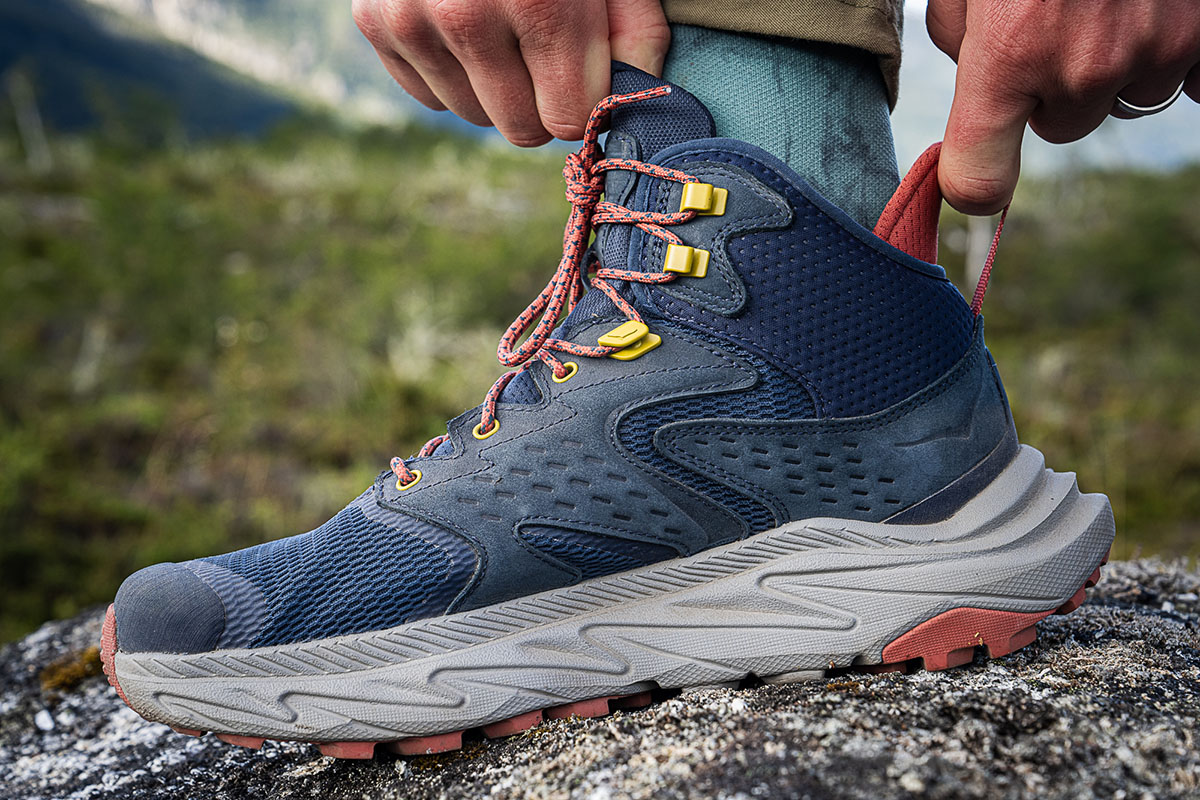
At 2 pounds 4 ounces per pair (4 oz. more than the past-generation model), the Anacapa 2 Mid GTX falls between the lightweight and midweight hiking boot categories. For comparison, it stacks up relatively favorably to similarly intentioned models including La Sportiva’s Nucleo High II GTX (2 lb. 1.6 oz.), Asolo’s Falcon Evo GV (2 lb. 2.6 oz.), and Hoka’s own Kaha 2 Mid GTX (2 lb. 1.6 oz.). You can go even lighter with a true mid-height trail runner like Hoka’s Speedgoat 5 Mid GTX (1 lb. 8.8 oz.) or Altra’s Lone Peak All-Wthr Mid 2 (1 lb. 14 oz.), but those come with notable compromises in protection, durability, and support. All in all, I feel that Hoka really nailed the balance between weight and on-trail performance.
Employing Vibram’s proven Megagrip compound, the Anacapa 2 Mid GTX is an overall very grippy and reliable boot. The lugs aren’t particularly deep, but it’s a solid on-trail performer—tacky enough to rely on when stepping over small rocks and roots, trudging through river crossings, and even charging up loose and steep dirt. Importantly, I’ve also found Megagrip rubber to be very long-lasting and resilient, even when frequently exposed to rough and rocky terrain.
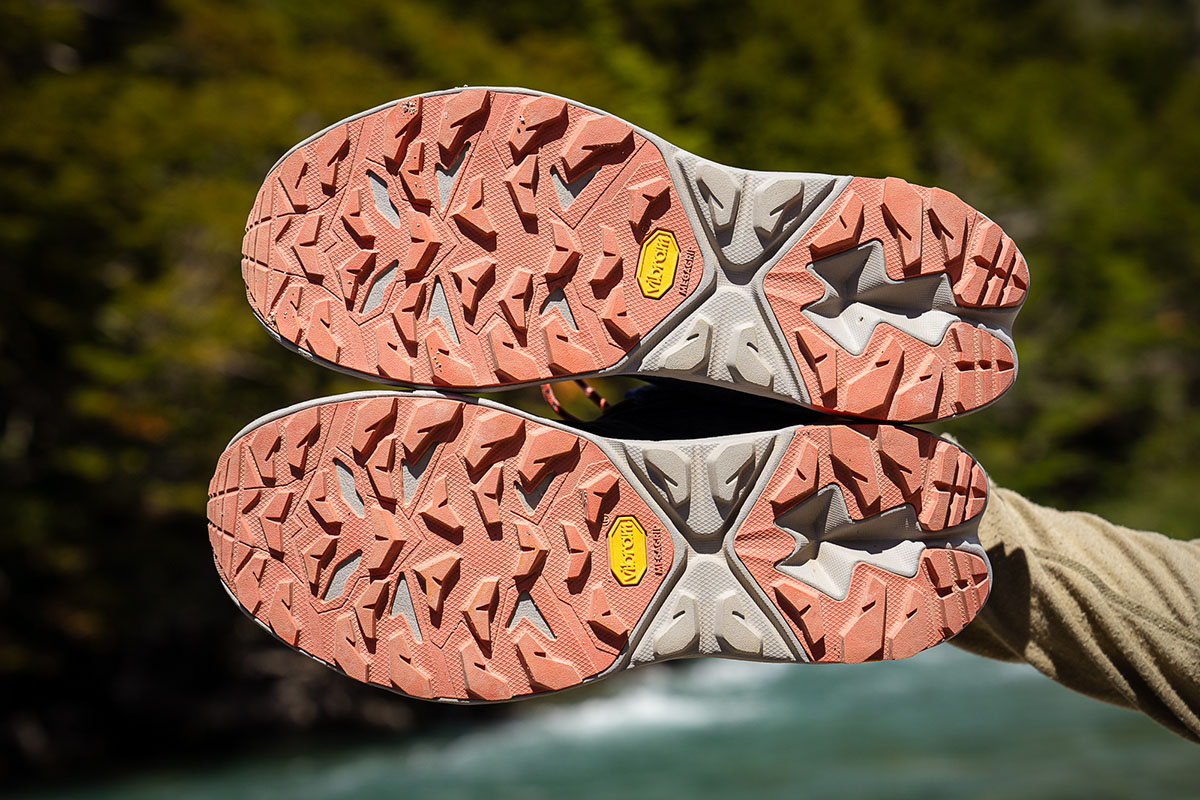
That said, it’s worth noting that I experienced some precision issues on technical terrain with the original Anacapa, and the latest iteration seems equally susceptible. The culprit seems to be the middle of the outsole (right under the arches), which has pads of blown rubber (like on a running shoe) that are effectively useless for grip. In addition, the back of the mid and outsole sticks out a good distance behind the heel, which led to me getting my foot caught a number of times in between rocks (this was especially annoying when descending). These instances were admittedly pushing the boots’ limits, however, and likely there won’t be issues for those who stick to maintained trails.
For a light and thickly cushioned boot that’s clearly intended for fast-moving hikers, I thought Hoka did a nice job incorporating moderate levels of stability and support. Underfoot, the Anacapa is pretty flexible and does sit a little higher off the ground than I’m used to, but its wide base and modest stiffness keep it from feeling overly tippy or floppy on most terrain. It’s not very confidence-inspiring when traversing, with plenty of bend at each angled step, but on-trail hikers and backpackers likely won’t have too many complaints. It’s a similar story along the sides: Unlike mid-height trail runners, the Anacapa actually feels like a hiking boot, although it still won’t be confused with a burlier and more beefed-up model like Lowa’s Renegade or Salomon’s Quest 4. All told, if you keep your pack weight in check—and don’t mind the slightly taller height—I think the vast majority of hikers will be happy with the result.
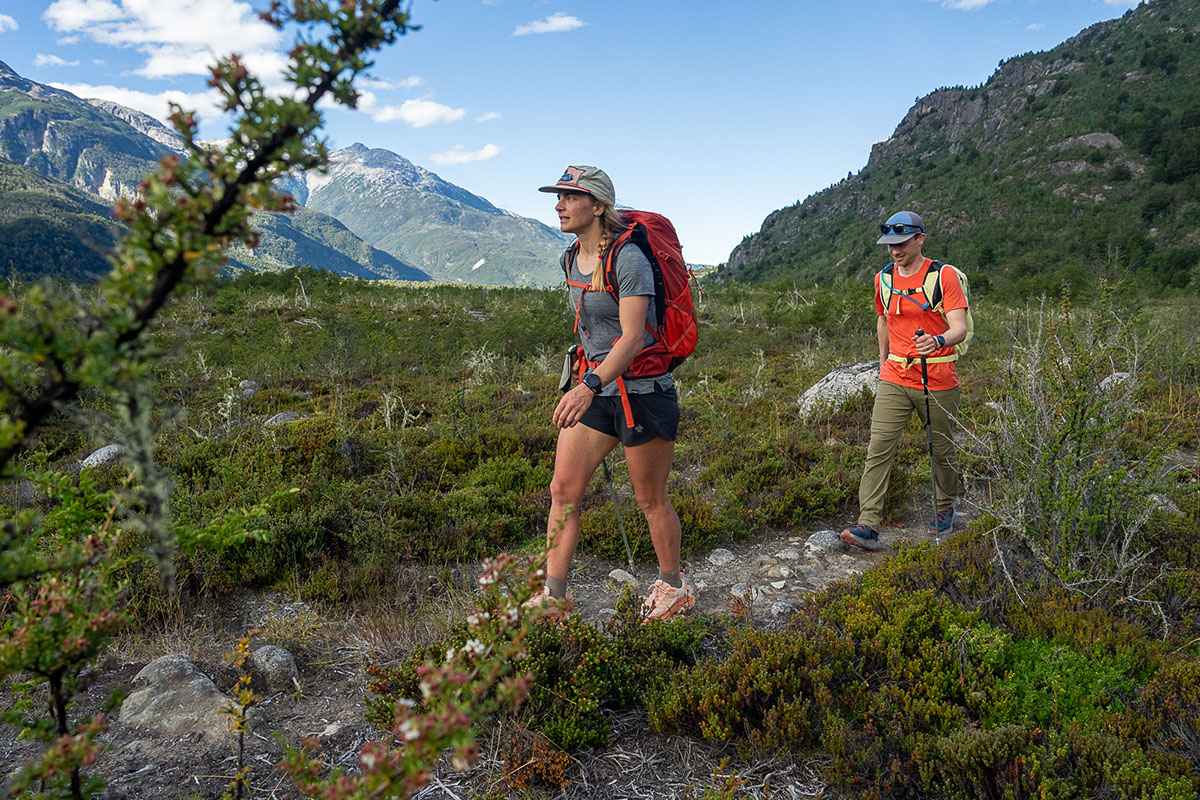
Like its predecessor, the latest Anacapa 2 Mid GTX incorporates the ubiquitous Gore-Tex liner. The results have been as expected: It’s held up nicely through creek crossings and in boggy conditions, and I’ve experienced no leakage or failures to date. The nubuck leather upper also does a nice job keeping the boot from absorbing water during those aforementioned crossings. The only potential issue to be aware of is that the waterproofing only goes partway up the heel—again, the collar dips pretty aggressively down in that spot—so you’ll want to be mindful of water depth before stepping in.
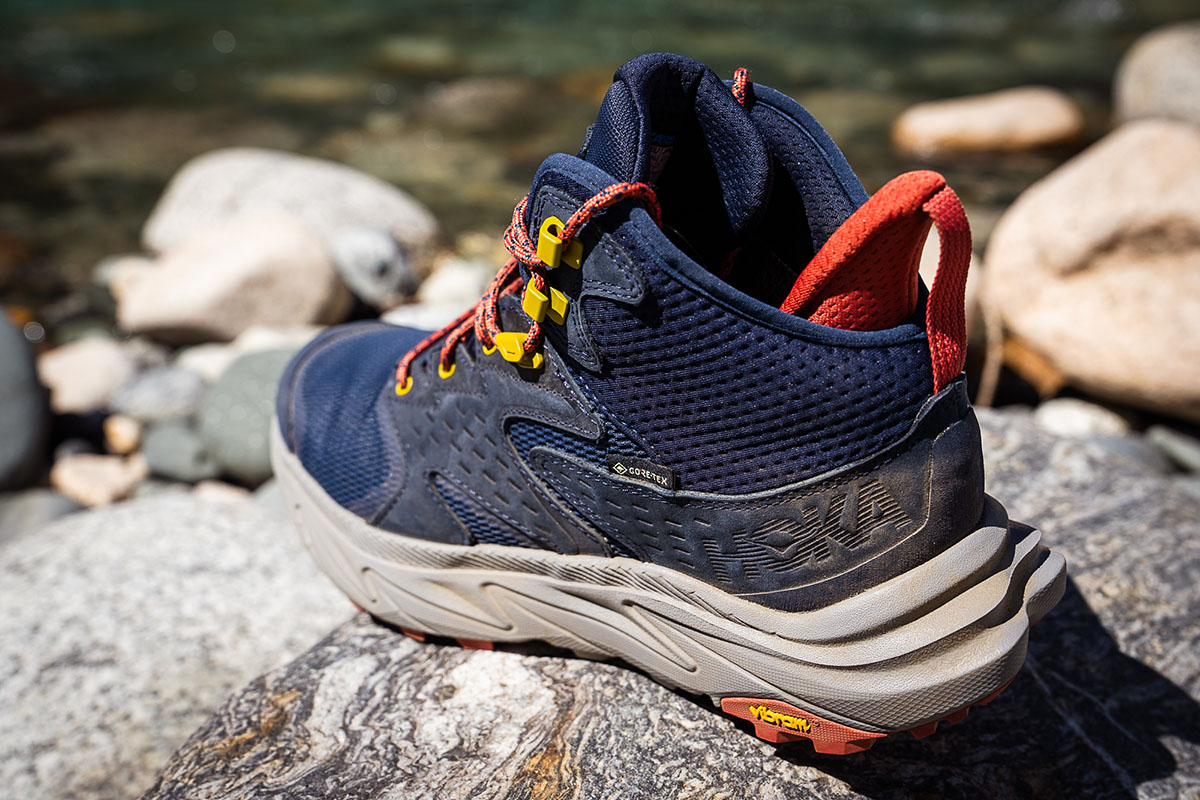
We experienced very warm weather in Patagonia (temperatures reached into the mid 80s Fahrenheit), and as a result, I ended up with fairly warm and sweaty feet by the end of each day. The Gore-Tex liner was largely to blame here (the nubuck leather upper certainly doesn't help), but it’s not out of the ordinary for me to run hot with waterproof footwear in the summer. Stacked up to the competition, I’d say the Anacapa is about average. If you run particularly warm or plan to get out in hot and dry climates frequently (think the Utah desert), it’s probably worth opting for one of the non-waterproof Anacapa Breeze models.
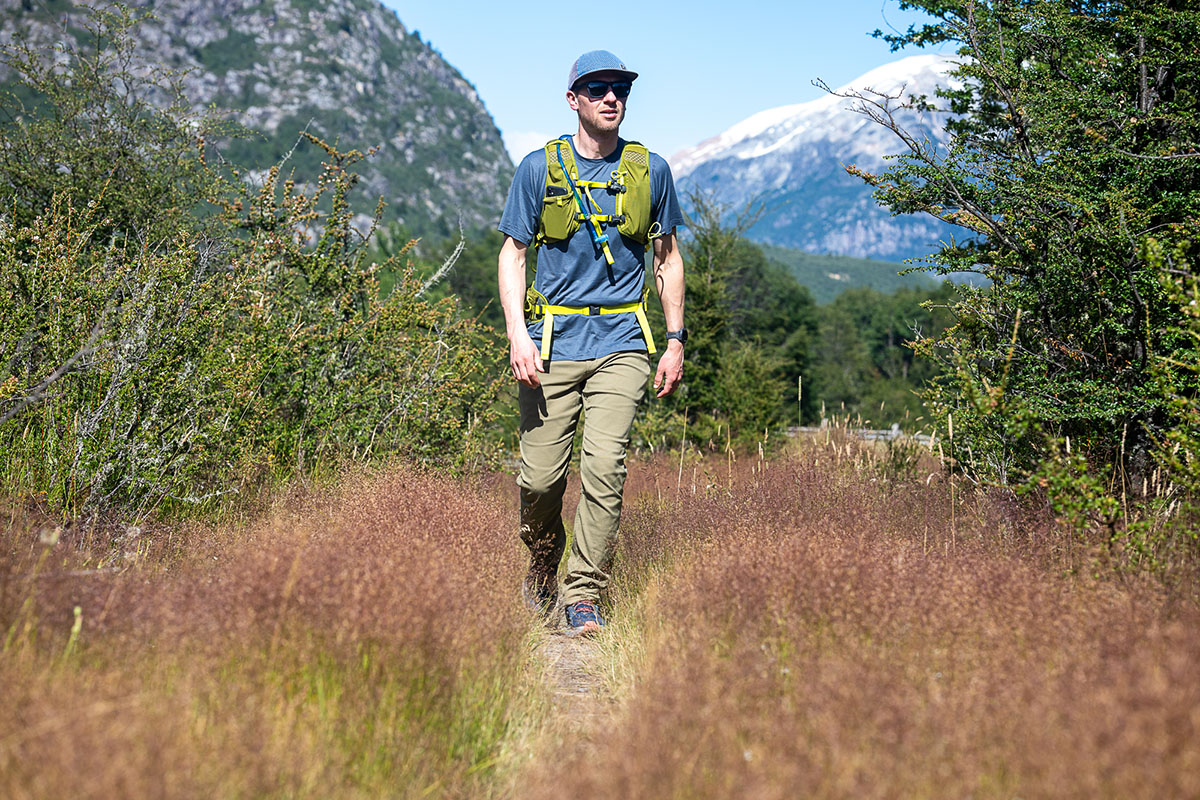
In the bid to save weight, Hoka did make some light concessions in terms of protection with the Anacapa 2 Mid. As I mentioned above, there’s plenty of cushioning around the ankles, but the collar drops pretty aggressively at the back and leaves a portion of your heel exposed to scrapes. Another issue with the original Anacapa was its lack of a full rubber toe cap, which resulted in feeling more of the impact when inadvertently kicking rocks along the trail. Thankfully, Hoka addressed this issue with this second iteration by adding more rubber at the front, which was a welcome change along the rough and varied terrain we encountered in Patagonia. I’d still rate the boot’s protection as moderate, but it’s plenty for on-trail use and a notable step up from mid-height trail runners like the aforementioned Speedgoat 5 Mid GTX and Lone Peak All-Wthr Mid 2.
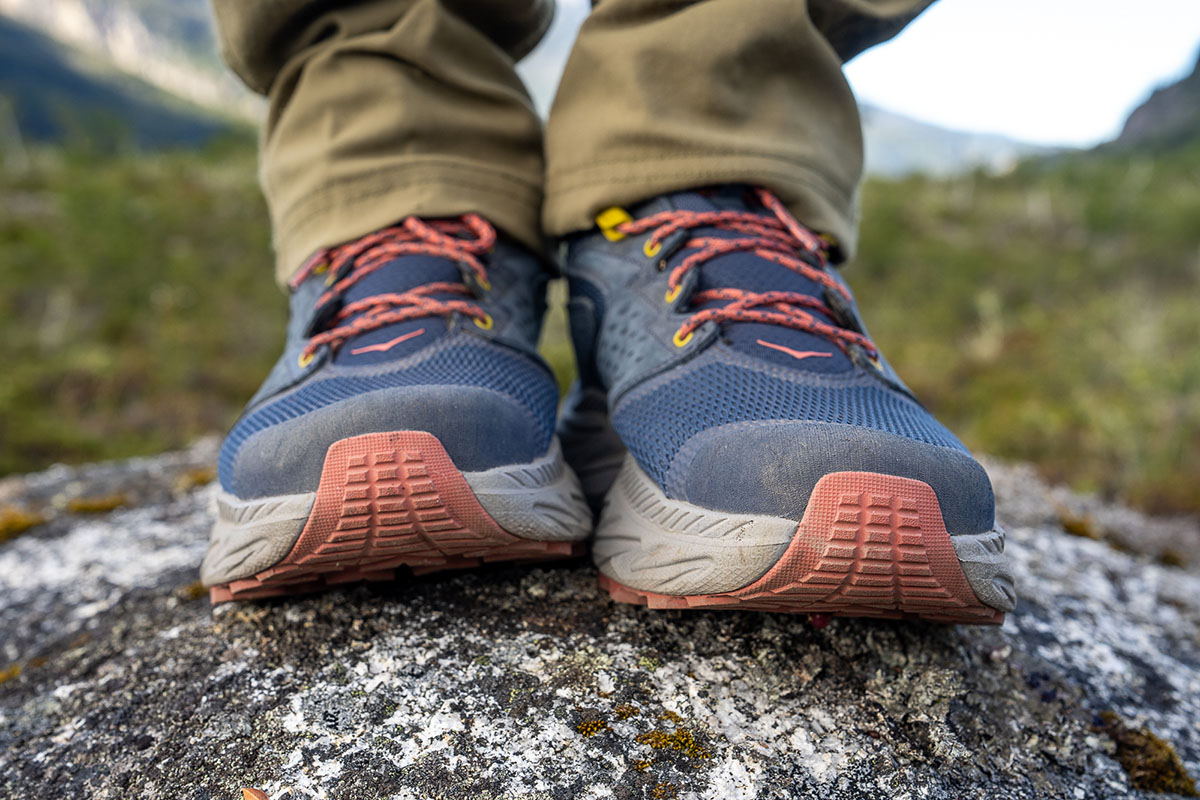
Similar to my experiences with the boot’s protection, durability is a bit of a mixed bag with the Hoka Anacapa 2 Mid GTX. On the positive side, it’s clearly well made, the sections of leather add a nice dose of toughness, and you get quality features like the Vibram Megagrip rubber, Gore-Tex liner, and sturdy eyelets (two plastic and one metal) for the laces. And at $195, the Anacapa is a solid all-around value considering its premium build.
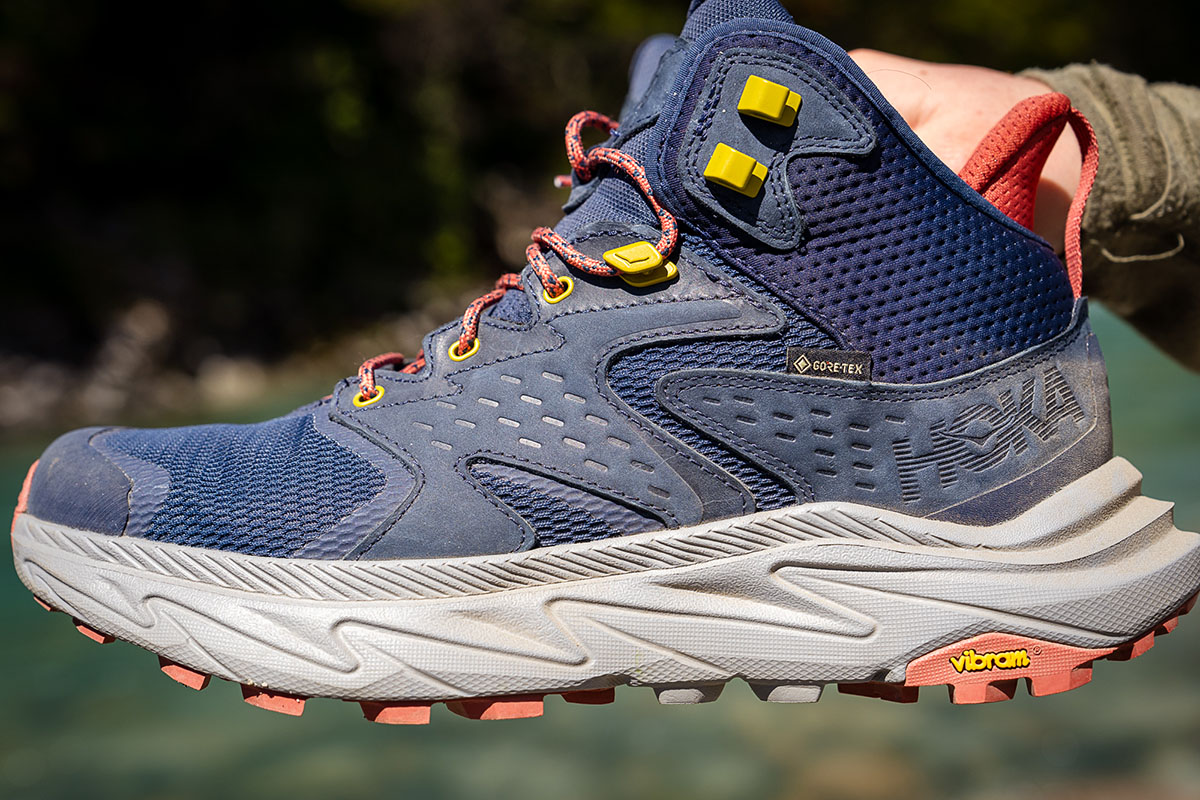
The main knock I have is related to those exposed sections of blown rubber on the bottom of the sole. In testing the original Anacapa Mid, these pads had a negative impact on grip when scrambling and started to show significant signs of wear very early on, including several scrapes and tears. It’s true that the updated version has a little less blown rubber, and the boot will likely still have an average lifespan—that middle section will probably just go flat after a while—but I think Hoka could’ve done a better job maximizing durability by giving the Anacapa a full rubber outsole (like they did with their Speedgoat hiking boot).
Overall, I feel that Hoka nailed the fit part of the equation with the Anacapa 2 Mid. It’s a just-right shape that should make a lot of folks happy: There’s enough space in the toe box to let your toes splay without feeling sloppy, and the narrower heel—combined with the effective lacing system—kept my feet securely in place throughout the day. For reference, I ordered my standard men’s size 9 in the boots and had no issues in terms of length or width. That said, I did need to size down in the low-top version that I was also testing in Patagonia (here’s my in-depth review), so I’d recommend trying the boots on before buying to ensure that your usual size will work.
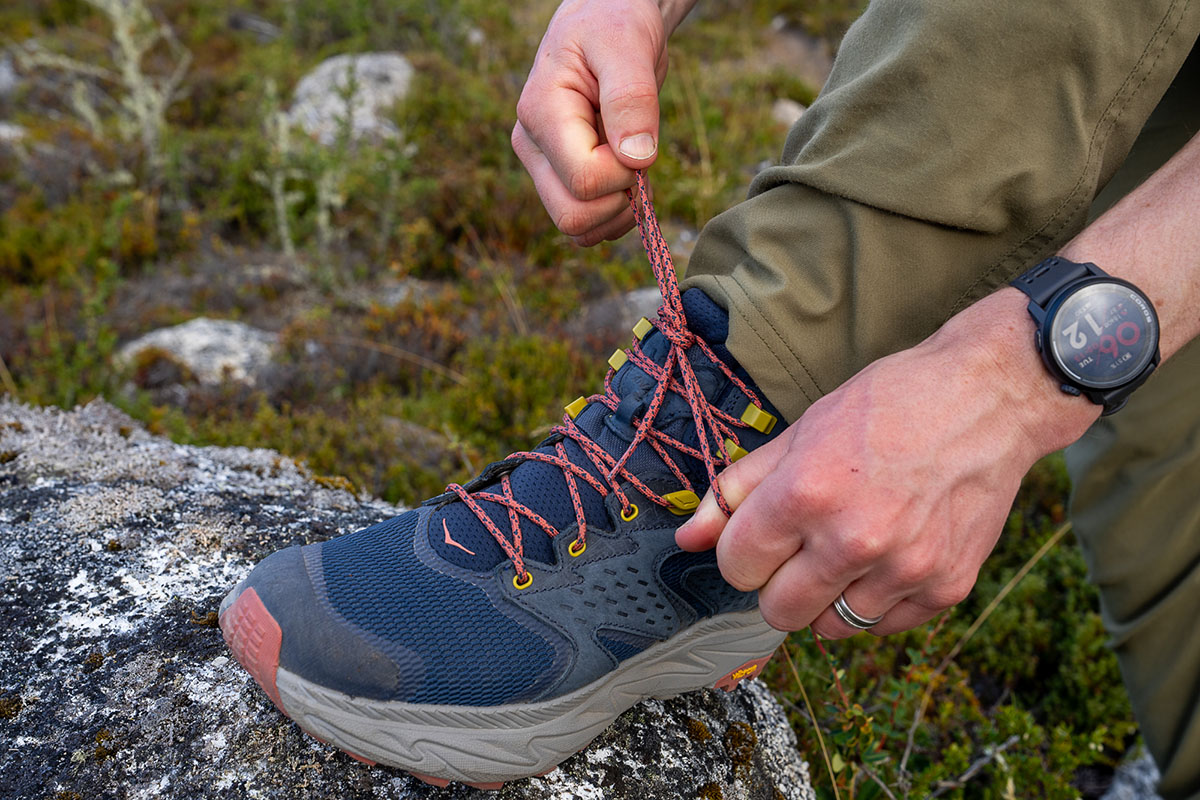
Another key component of a boot’s fit is its lacing system, and I have mixed feelings about the Anacapa 2 Mid’s. On the bright side, the boot features two eyelets at/above the ankle (most lightweight boots only include one), which resulted in a noticeably more secure and locked-down feel. It also helps avoid the debris-prone gap at the collar that’s characteristic of many lightweight hiking boots, including Salomon’s X Ultra 360 Edge Mid GTX that we also tested in Patagonia. However, below the top two eyelets, the laces are stiff to adjust and difficult to snug down over the top of the foot. With frequent water crossings that required removing and quickly retying my boots, I often ended up with a looser fit than I’d prefer.
We’re excited to see that Hoka incorporated several eco-friendly measures into the Anacapa 2 Mid GTX’s design. The brand is aiming to lower its emissions by about 25% per shoe by 2030. To do that, they’re moving away from petroleum-based products. In the Anacapa, for example, the boot features a liner that’s made from 50% soybean oil and a sugarcane-based EVA midsole. And Hoka didn’t stop there: The shoe also features recycled polyester materials at the collar, tongue, mesh, and laces, along with a Gore-Tex membrane that's made with 71%-recycled polyester. Finally, the leather upper is certified as “gold-rated” by the Leather Working Group, which is the organization’s top designation and quantifies responsible leather production with measures like traceability of the hides, energy and water consumption, worker safety, and more. Taken together, we think these additions only boost the boot’s overall appeal.

We brought the men’s Anacapa 2 Mid GTX to Chile for testing, and the boot is also offered in a nearly identical women’s version. The women’s Anacapa 2 Mid GTX costs the same at $195 but checks in a little lighter (1 lb. 13.4 oz. per pair), is offered in different colorways, and has a slightly lower-volume fit. Hoka also sells the non-waterproof Anacapa Breeze Mid that costs $25 less than the Gore-Tex-equipped model and weighs 1 pound 13.2 ounces for the men’s boot. Finally, for those who don’t want or need the ankle coverage, Hoka offers the Anacapa in low-top versions with or without waterproofing, which cost $180 and $155 respectively.
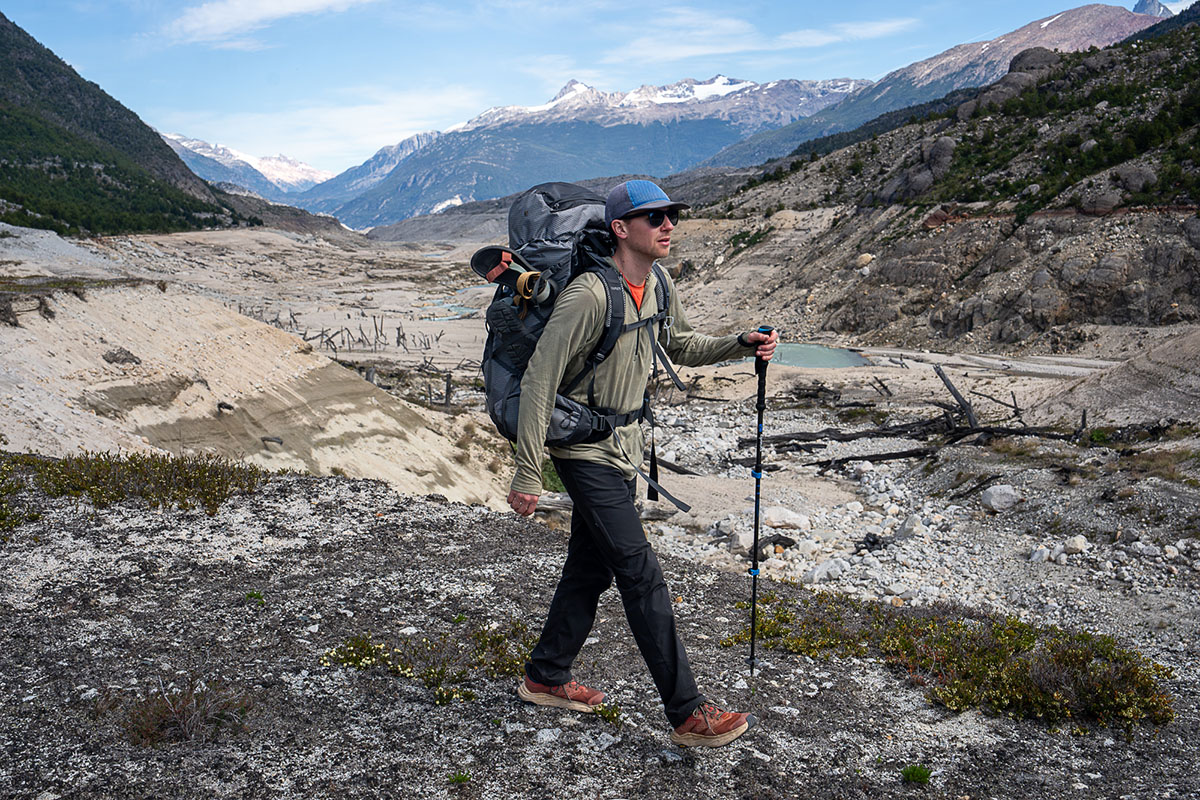
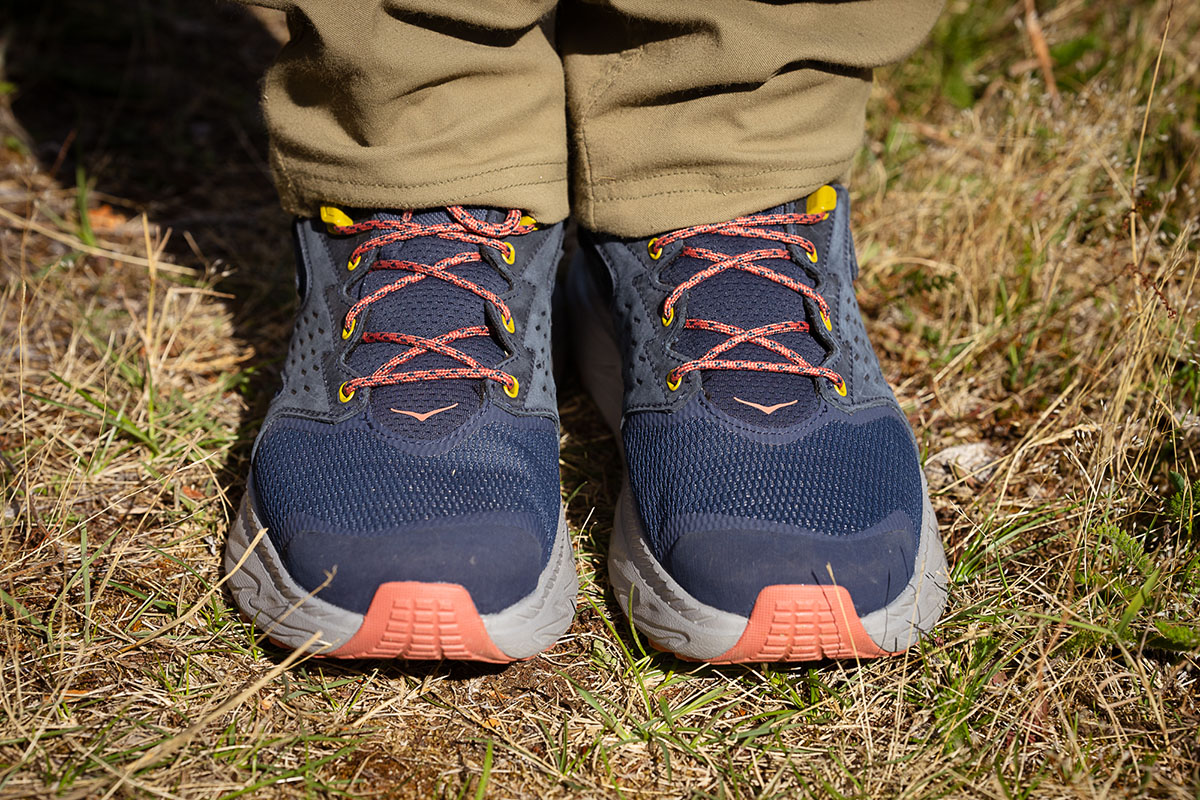
| Boot | Price | Category | Weight | Waterproof | Upper |
|---|---|---|---|---|---|
| Hoka Anacapa 2 Mid GTX | $195 | Light/mid | 2 lb. 4 oz. | Yes (Gore-Tex) | Nubuck leather / mesh |
| Salomon X Ultra 4 Mid GTX | $175 | Lightweight | 1 lb. 14 oz. | Yes (Gore-Tex) | Leather / textile |
| Danner Trail 2650 Mid GTX | $200 | Lightweight | 1 lb. 12 oz. | Yes (Gore-Tex) | Leather / mesh |
| Hoka Speedgoat 5 Mid GTX | $180 | Lightweight | 1 lb. 8.8 oz. | Yes (Gore-Tex) | Synthetic |
| Hoka Kaha 2 Mid GTX | $240 | Lightweight | 2 lb. 1.6 oz. | Yes (Gore-Tex) | Nubuck leather |
| Altra Lone Peak All-Wthr Mid 2 | $180 | Lightweight | 1 lb. 14 oz. | Yes (eVent) | Synthetic |
Hoka’s Anacapa 2 Mid GTX stands out among the hiking boot competition for its over-the-ankle coverage in a light, well-cushioned, and smooth-riding design. Salomon’s popular X Ultra 4 Mid GTX shares many of those same features but strikes us as the more well-rounded pick. In parsing out the differences between the two boots, the Hoka is quite a bit more padded, especially underfoot, and its rockered shape makes it very easy to stack up miles quickly. However, the Salomon is lighter at 1 pound 14 ounces and offers superior all-around grip and durability thanks to its full rubber outsole (especially if you’ll be scrambling or venturing off trail). Tack on a $20-cheaper price tag, and we consider the X Ultra to be the better quiver-of-one option for hiking and backpacking.
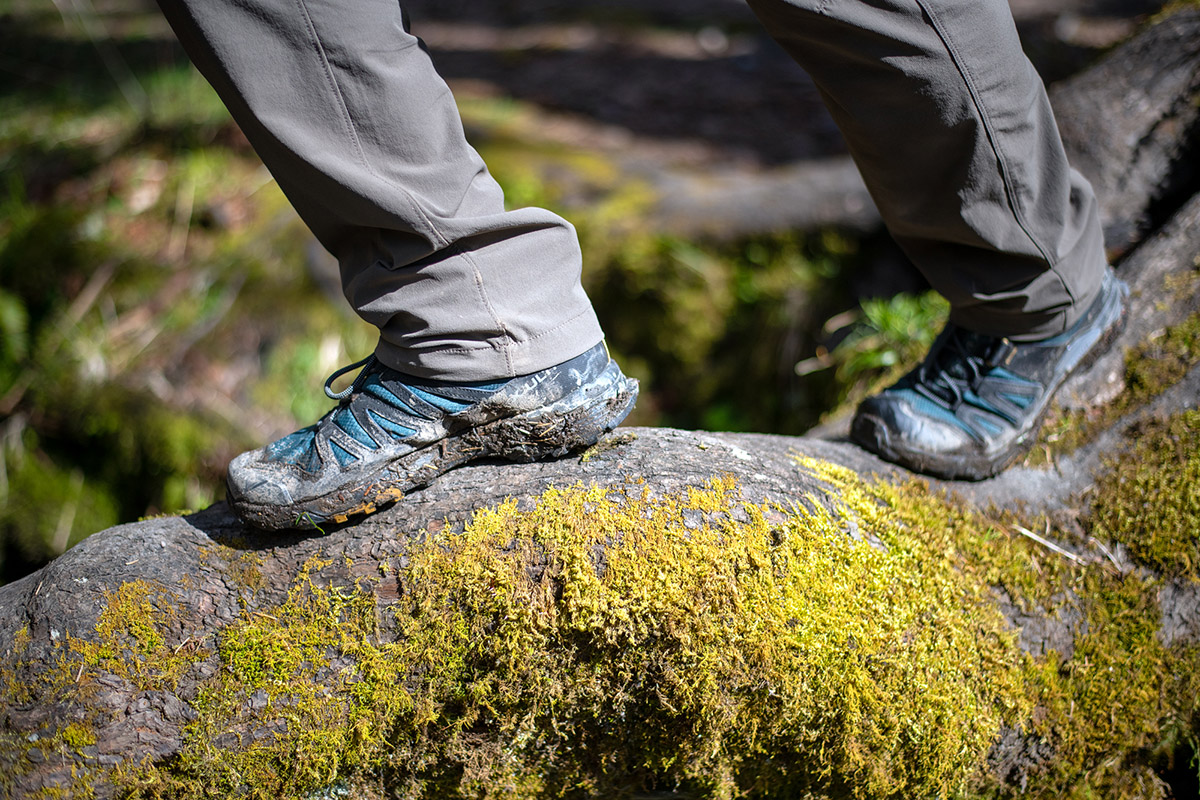
Danner offers another intriguing lightweight hiker in their Trail 2650 Mid GTX. The Danner is impressively light at just 1 pound 12 ounces per pair, good-looking with a sleek and modern leather build, and offers better traction with a full Vibram Megagrip outsole and more aggressive lug pattern. The biggest downsides are support and fit: The Trail 2650 falls short in terms of stability with a noticeably floppy feel, and we found the “regular” version of the boot to be too narrow, while the “wide” was overly roomy. Finally, from a comfort perspective, the Danner simply wasn’t a standout, with less cushioning than the Anacapa that led to some foot fatigue after long days on the trail. For $5 less, we think most hikers and backpackers will be happier with the more capable and comfortable Hoka (despite the weight penalty).
Next up is an in-house alternative to consider: Hoka’s Speedgoat 5 Mid GTX. A mid-height version of their very popular trail runner, the Speedgoat Mid is significantly lighter (1 lb. 8.8 oz.) but less protective and supportive than the Anacapa Mid. This makes the Speedgoat the better match if you plan to mix in stretches of running, although the Anacapa is no slouch and still has a quick-moving personality. And the Speedgoat does have the better outsole design for grip and longevity with full rubber covering the bottom, but the Anacapa’s sturdier build makes it the more capable option for backpacking. In the end, a final decision will come down to your objectives and preferences on weight and flexibility versus on-trail performance.
Joining the Anacapa and Speedgoat is Hoka’s top-end hiking boot: the Kaha 2 Mid GTX. Like the Anacapa Mid, the Kaha is a premium design with a high-quality leather upper, proven Vibram Megagrip tread, and great cushioning on the tongue and collar. In testing the Kaha, we also liked its rockered shape and moderate flexibility, which made it easy to move quickly on the trail. The biggest drawback is the firm foam midsole, which lacks the cushy comfort we’ve come to expect from Hoka. We also came away with a couple of fit-related gripes, including a wider-than-average heel that led to issues with rubbing (for more, see our in-depth Kaha 2 review). For a considerable $45 less, we think the Anacapa is the better value and overall performer.
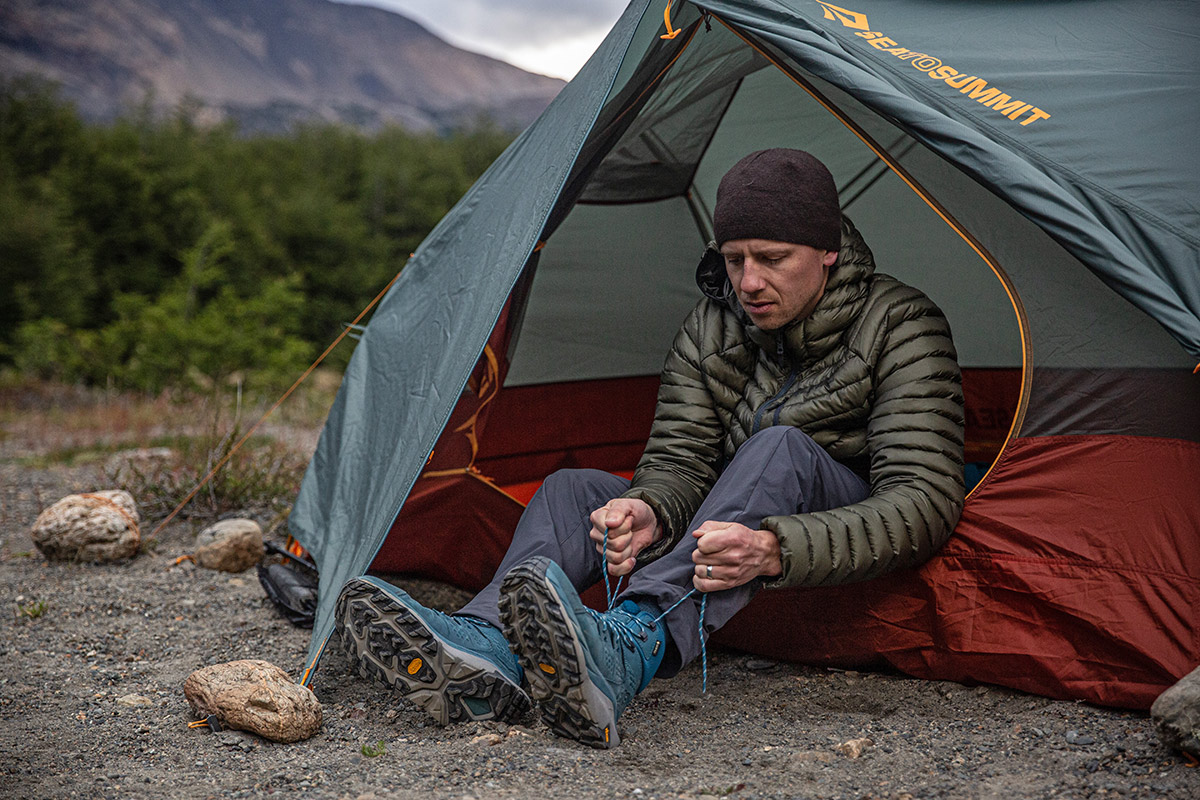
Last but not least is another mid-height take on a popular trail runner: Altra’s Lone Peak All-Wthr Mid 2. Compared to the Anacapa, the Lone Peak has a lighter (1 lb. 14 oz.) and airier build but trades the Hoka’s well-cushioned midsole for Altra’s signature zero-drop shape. The result is better stability and connectedness to the trail, although we found the Lone Peak’s roomy toe box and soft midsole to feel pretty sloppy on rocky and uneven terrain. The Anacapa is also the more durable option of the two, although the sections of blown rubber result in a drop in traction compared to the Lone Peak. But if you don’t plan on mixing in any stretches of running, the Hoka hiker is overall the more capable pick.
If you’re thinking about buying gear that we’ve reviewed on Switchback Travel, you can help support us in the process. Just click on any of the seller links above, and if you make a purchase, we receive a small percentage of the transaction. The cost of the product is the same to you but this helps us continue to test and write about outdoor gear. Thanks and we appreciate your support!
Depending on the seller, most products ship free in the United States on orders of $50 or more. International shipping availability and rates vary by seller. The pricing information on this page is updated hourly but we are not responsible for inaccuracies.